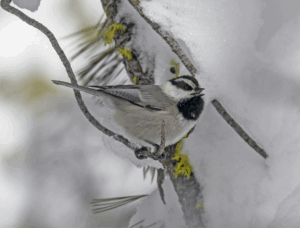
Birds and other animals have lived within cities for about as long as humans have been building them. Yet the constant hum of traffic and televisions as well as the 24-hour exposure to city lights is affecting birds, and perhaps their evolutionary trajectory, too.
For one thing, many bird species can’t handle city life.
“Noise and light pollution….displaces a lot of other species of birds. So birds that cannot handle the level of light pollution or noise pollution usually are displaced from cities and that reduces biodiversity,” says Dr. Jenny Ouyang, a biologist at the University of Nevada Reno. She has been researching stress responses in birds for the past four years.
To study the impact of noise and light on birds, Ouyang measures a hormone called corticosterone, which can spike when an animal is under stress.
“What we are finding is that urban birds have higher levels of corticosterone than rural birds,” says Ouyang. Corticosterone levels naturally fluctuate depending on a bird’s activities– for example, corticosterone levels are higher during breeding season when the birds are more active. That’s why Ouyang is conducting experiments on captive birds where she can more closely analyze which factors are causing changes in a birds’ life.
Ouyang says urban birds seem more adapted to aspects of city life.
“The urban birds seem to be a lot less scared of humans, and they seem to be more reactive towards, novel objects like new objects that you place near their nest. And they also secrete, they also have more levels of this hormone that allows them to live in these cities.”
Both birds and humans produce corticosterone, called cort for short; it’s a hormone that causes the fight or flight response. Ouyang uses the hormone as a measure of stress, and charts its level changes in zebra finches and house sparrows in different settings.

While there’s still more research to be done to fully understand the impacts of noise pollution on birds, Ouyang says that her studies do show that light pollution is affecting birds.
“Light pollution affects our circadian rhythms, our daily melatonin levels and lots of other things that are required for maintaining our health and wellbeing,” says Ouyang. For one, “it shifts their breeding success. They sometimes have smaller young in urban areas due to lower availability of food.”
Ouyang says birds that are already accustomed to urban environments have adapted, and don’t see the same negative impacts.
“Our artificial light and our noise and those things that we’re putting into the environment– how is that impacting the health of the animals that don’t really have a choice and they’re just living here?” says Valentina Alaasam, a researcher in Ouyang’s lab. She’s specifically looking into how birds are responding to noise pollution.
Alaasam explained that birds in urban areas are getting smaller and are having a harder time reproducing than birds in rural areas. Their sleep cycles are also changing to be more like humans.
Using house sparrows and zebra finches, Alaasam and Ouyang simulated an urban environment that birds might experience in urban cities to see if birds are adapting to our environment.
All across the country, field researcher Jenn Atherton has seen similar impacts of noise and light on bird populations. Atherton has lived all around the country, working for the California Forest Service and the Alaska and North Carolina Department of Wildlife, helping researchers understand if and how birds are being affected by human activities.
“Especially when it comes to wildlife, like the urban rural differences, people don’t realize what a change [there is] just having people around,” says Atherton. “Even Alaska and Georgetown, these were small towns where there weren’t a lot of people, but you can see in these towns that there wasn’t the same [animal] diversity.”
Atherton says when she went hiking two plus hours outside of town, the environment had a much greater biodiversity: “We were in the middle of nowhere. And then you see all these animals that you’re not going to see anywhere else.”
Even in a small town, “the lights in peoples’ yards and the dogs barking… dogs barking drove me nuts because you could be way out there, and dogs totally would stress out these birds. Most of these birds, they were there but they weren’t nesting.”
But some birds clearly survive in urban areas. Researcher Jennifer Heppner, also in Ouyang’s lab, wanted to understand how the animals adapt.
She’s conducting a breeding experiment to see if some of the adaptions to light and noise stressors can be inherited.
“One of our groups is highly reactive to cort, so their cort increases. When they are handled and experience a stressor, they have a higher stress response. There is another group that has a lower stress response, and another control group,” says Heppner.
“The plan is to continue having them reproduce, and see if that cort phenotype of high stress response and low stress response is heritable.”
Depending on the experiment’s results, Heppner could show that birds are genetically evolving to deal with new stressors.





